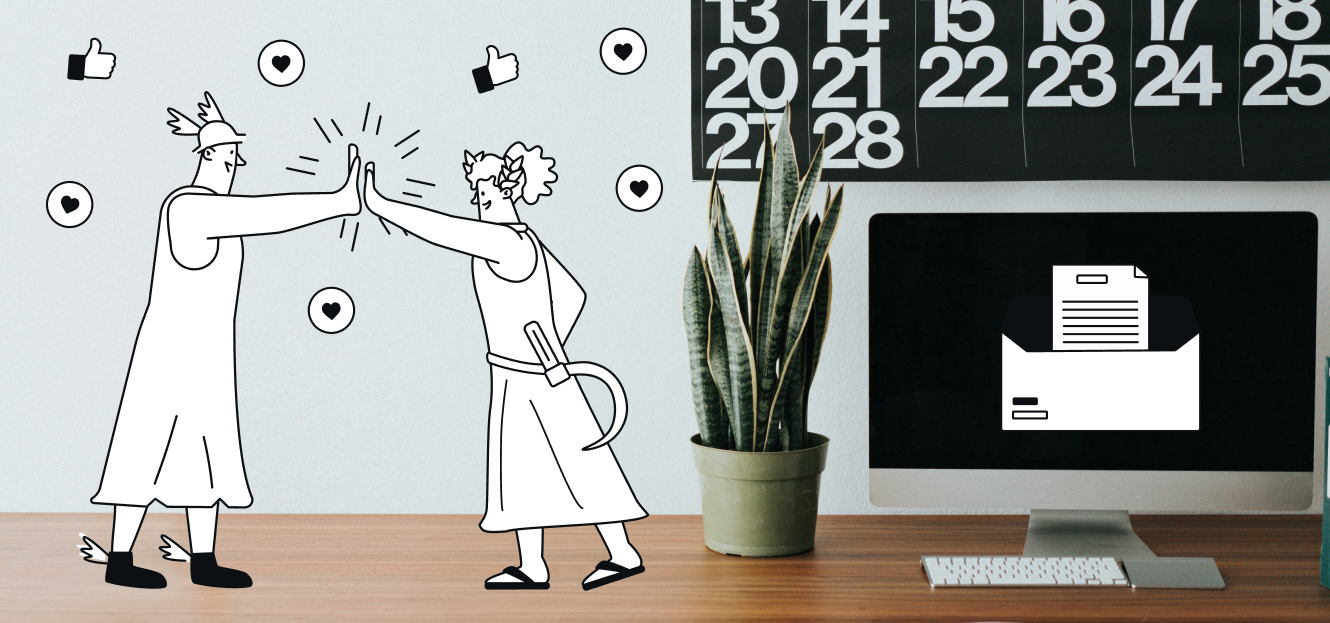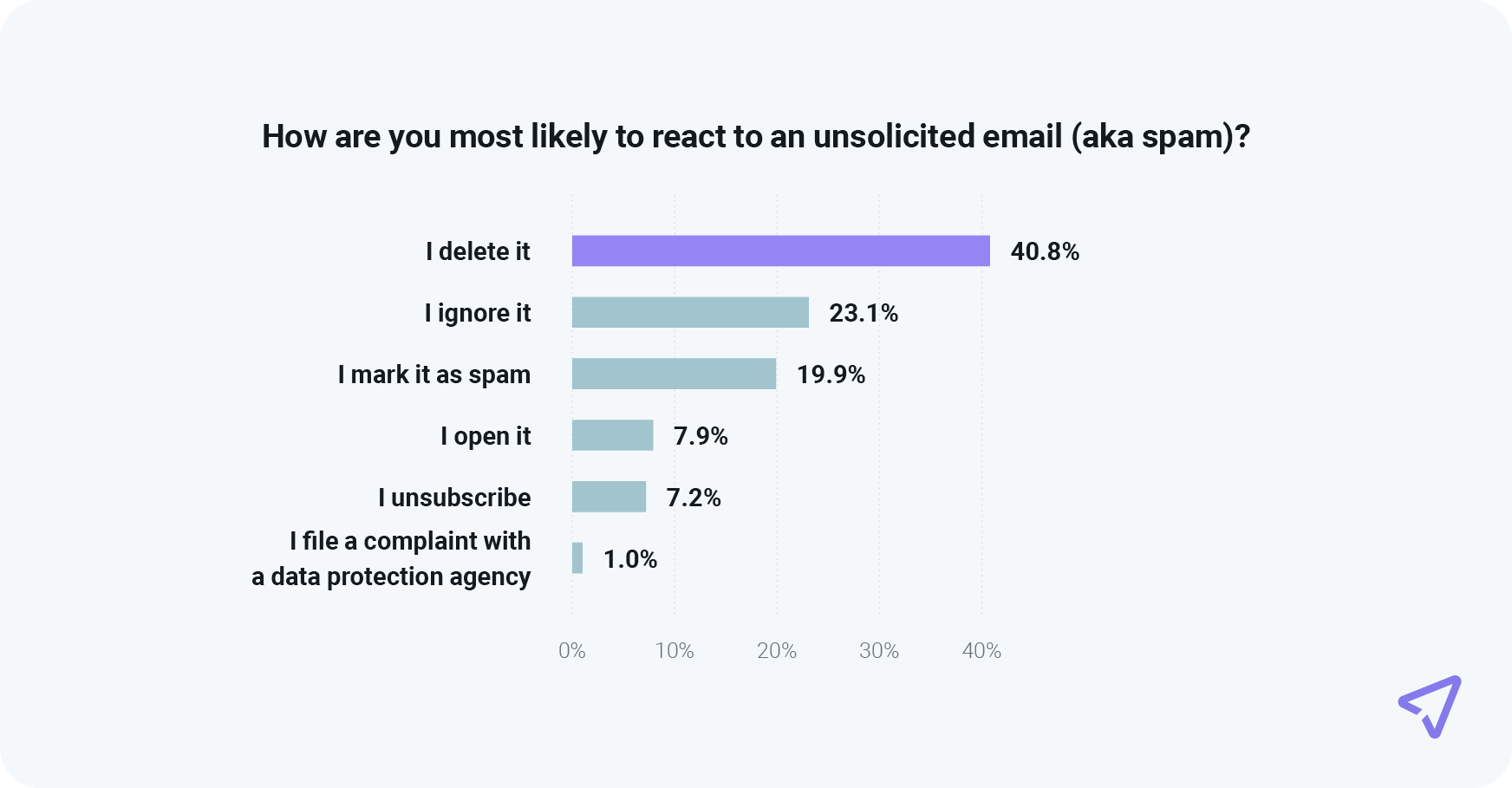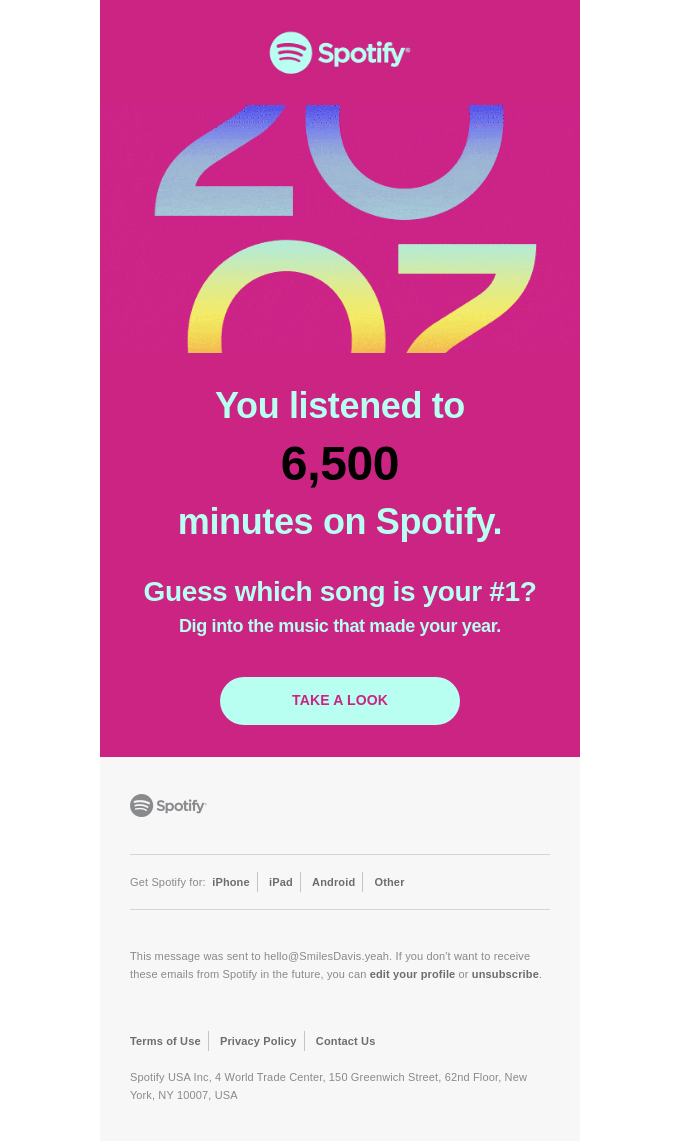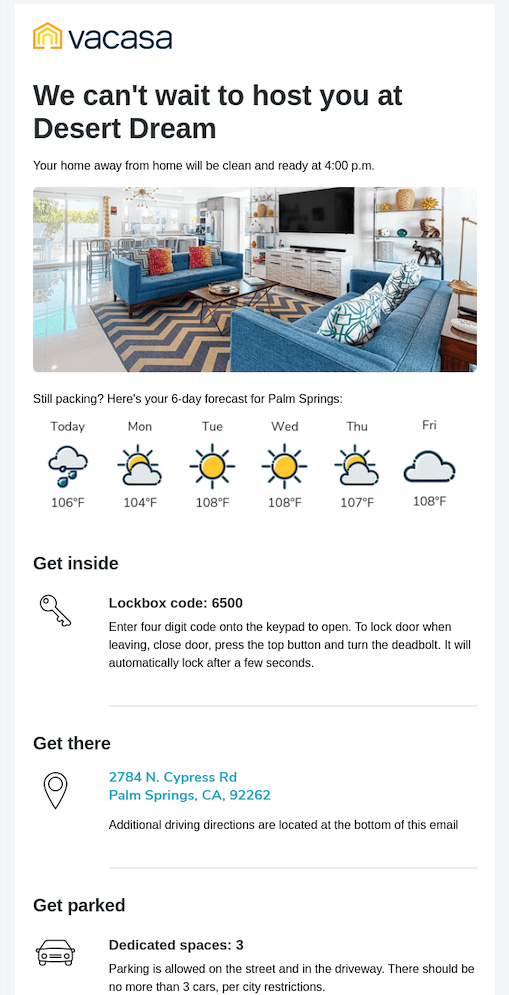Marketing
Permission-based marketing: Are your messages anticipated, personal, and relevant?
Permission-based email marketing is a simple concept, but it’s not always easy to accomplish. Find out why you must deliver messages that are anticipated, personal, and relevant if you want to improve email engagement and customer communications.

PUBLISHED ON
It’s been 25 years since pioneering digital marketers defined email marketing as we know it. Permission-based marketing practices set the standard for how brands communicate with customers and prospects.
Of course, it’s easy to say your email strategy follows the guidelines of permission-based marketing without fully understanding what that means. It’s one of those ideas that’s so simple marketers take it for granted, and sometimes (unfortunately), we ignore it.
Let’s explore how permission-based email marketing comes down to three words: anticipated, personal, and relevant.
Table of contents
Interruption marketing vs. Permission marketing
The benefits of permission marketing
1. Get permission first
2. Send anticipated emails
3. Make your emails personal
4. Deliver relevant emails
5. Let them go when they’re ready
Get started with multichannel permission marketing
How Seth Godin saved email marketing from disaster
The year was 1999. While most of the world was worrying about the Y2K bug and a potential technological apocalypse, Seth Godin and his agency, YoyoDyne, were unveiling a new way to approach direct marketing in the age of the Internet. (Yes, this was back when people still capitalized “Internet.”)
The world wide web was new and exciting, but it was also the Wild West for spammers and scammers. This was a time, believe it or not, when people opened almost every email that landed in their inboxes. That meant it was the perfect channel for promotions and selling.
Seth Godin noticed a fork in the road. Marketers could choose a path in which they used a megaphone to yell at consumers, or they could take the road less traveled. Instead of forcing marketing messages on people, brands could form a relationship with consumers who wanted to hear from them. The truth is, marketers still choose from those options today...
Interruption marketing vs. Permission marketing

Godin’s influential book, Permission Marketing, seems like common sense now. But when it was published, people viewed it as revolutionary and controversial. The Direct Marketing Association even kicked Seth out because of it. That’s because his ideas challenged the status quo of what he called “interruption marketing.”
Interruption marketing was (and often still is) the norm. It includes TV spots and radio ads that interrupt your favorite shows and music. It could also be the junk mail filling up your mailbox, the print ads in the middle of a magazine article, or billboards blocking the scenery along your drive.
Those interruptions didn’t disappear in the digital age. We still have YouTube pre-rolls, newsfeed ads in social media, and pop-ups on websites. Interruption marketing gets right up in your face. Permission marketing is different.
With permission-based marketing, you give current and potential customers the power to choose. They raise their hands and say they want to hear from you after you ask for that privilege. Seth Godin realized the email inbox was a private, personal space, and unsolicited messages from brands were an intrusion. Yet it’s also an ideal channel for delivering permission-based marketing.
In the book, he compared the permission-based approach to dating. He described it as having the power to turn strangers into friends and friends into lifelong, loyal customers. Here’s a dating analogy from Permission Marketing:
“Walking into the singles bar, the Interruption Marketer marches up to the nearest person and proposes marriage. If turned down, the Interruption Marketer repeats this process on every person in the bar... A Permission Marketer goes on a date. If it goes well, the two of them go on another date. And then another … And finally, after three or four months of dating, the Permission Marketer proposes marriage.”
Seth Godin, Author, Permission Marketing
So, permission marketing is relationship-based, and it takes time. But if it’s slower than interrupting consumers with mass marketing messages, can it really be better?
The benefits of permission marketing
Here are just some of the reasons why using email to deliver permission-based marketing is a smarter strategy than traditional interruption marketing:
Reduce marketing waste: When you’re only delivering messages to people who want to receive them, you avoid the trap of marketing to people who don’t care about what you have to say or offer. Plus, permission marketing is more cost-effective than interruption marketing, which happens mainly through Paid channels.
Earn trust and loyalty: If you show customers and prospects that you respect them, they’ll view you as trustworthy and are more likely to remain loyal to your brand. Permission marketing shows subscribers you have their needs and interests in mind, not just the possibility of another sale. This also helps reduce customer churn.
Protect brand reputation: Unless they’re watching the Super Bowl, people hate most interruption marketing. Who wouldn’t? When consumers get sick of your ads, they get sick of your brand too. If you have permission to talk to consumers, you’re less likely to annoy them, and they’ll see your brand in a positive light.
Follow the law: Over the years, obtaining explicit consent to deliver marketing messages to consumers has become a legal matter. Using permission-based marketing helps ensure you comply with regulations like GDPR, the CAN-SPAM Act, and the CCPA.
Increase engagement and deliverability: When people raise their hand and say they want to hear from your brand, they are also saying they’re ready to engage with what you send them. That’s good for your email metrics and conversion rates as well as your sender reputation. Higher engagement means a better chance of reaching the inbox and avoiding the spam folder.
The biggest benefit of permission-based marketing is that it works. Applying the principles Seth Godin outlined a-quarter-century ago will make your email program and overall digital marketing efforts more effective. Here’s what Seth told Sinch Email on Acid when email marked its 50th anniversary a few years ago:
“When I wrote
Permission Marketing
, email was a zero-billion-dollar industry. I’d been developing Yoyodyne for 8 years by then - we invented email marketing as a non-spam commercial activity, and it’s bigger than ever. The most important lesson is still the same: Attention is scarce, and it doesn’t belong to you. You can earn it, but you can’t reliably demand it. If we bring humility to the table, understanding that we’re using something that can never be replaced, we have a better chance of serving our customers.“
Seth Godin, Best-selling Author
Thanks in large part to the concepts in Permission Marketing, 75% of consumers from five countries told us they prefer to hear from brands in their email inbox. It's unlikely this would be the case if legitimate brands used the email channel for interruption marketing (aka spamming people), and that’s why Seth Godin saved email marketing from disaster.
5 simple steps to permission-based email marketing
Yes, Permission Marketing came out 25 years ago, which feels like a century in “technological years.” And it’s true that much of it is now common practice. However, that’s because it is full of timeless advice for modern marketers.
When we surveyed consumers for our report, The path to email engagement 2024, results showed that the methods described in the book are not only what people want, it’s what they expect from brands. Here are five essential ways to achieve an effective permission-based email marketing strategy:
1. Get permission first
This is the obvious part of permission-based marketing. Whether it’s email, SMS, WhatsApp, or any marketing channel, brands should allow people to opt in before delivering promotional messages.
When sending promotional messages, the risks associated with sending unsolicited emails far outweigh any advantages. Most consumers in our global survey would either ignore or delete unsolicited emails from brands while nearly 20% would mark them as spam. None of these outcomes deliver positive results for your email program.

While a user-reported spam complaint is an easy way for mailbox providers like Gmail and Yahoo to find out you’re sending unsolicited mail, immediately deleting and ignoring emails are also strong signals that your messages belong in spam.
The first step is giving consumers a reason to sign up. Our survey found lots of consumers subscribe to a brand’s emails because your promotions are exactly what they want to receive. When we asked people to choose the primary reason they sign up, 32.7% chose regularly receiving special offers, while 23.6% want a one-time discount, and 15% want to hear about the latest updates. Those were the top three selections.
Whatever it is that prompts people to give you permission to email them, Seth Godin says you need to follow through on that promise, and that’s where it should end:
“In order to get permission, you make a promise. You say, ‘I will do X, Y and Z, I hope you will give me permission by listening.’ And then, this is the hard part, that’s all you do.”
Seth Godin, Author, Permission Marketing
For more advice from Seth on this topic, check out our guide to building an engaged contact list.
2. Send anticipated emails
Seth Godin identified three ways to cut through the clutter and deliver effective, permission-based marketing. He says your emails must be anticipated, personal, and relevant.
The simplest way to define an anticipated email is one that someone looks forward to receiving. There probably aren’t many messages in your inbox that you feel that positively about, but we bet there are a few. Those campaigns and newsletters come from senders delivering something you enjoy, value, or are curious about.
Imagine having subscribers who are excited about your next email. It almost sounds unrealistic, but it’s not out of reach. If you decide to create an email newsletter, your goal is to make it so good it becomes their favorite. One excellent example of an anticipated email campaign is Spotify’s yearly Wrapped email announcement, which also happens to be very personal and relevant.

Of course, you don’t want to overdo it. Acting like a clingy date who bombards their significant other with messages is one of the fastest ways to see your unsubscribe rate skyrocket. The tricky part is – people have different expectations and preferences.
Our survey found a wide range of opinions on how often consumers anticipate receiving promotional emails from brands. So, how do you find the right sending frequency when 22.8% of consumers are open to hearing from you every day, more than 25% expect weekly emails, and another quarter only want to hear from you once or twice a month?

Marketing teams can monitor levels of engagement to proactively manage these consumer expectations with strategic list segmentation based on behavior patterns. Those who engage regularly receive more frequent emails. Those who engage less often get monthly promotions. Email preference centers are yet another way to enhance permission-based marketing. A preference center puts even more power in your subscribers’ hands, letting them tell you when and why they want to hear from you.
Delivering value with email marketing is most important - but so is consistency. Seth Godin says there’s a surefire way to find out if you’re truly sending anticipated email campaigns:
“The test is easy: If you didn’t send out your emails tomorrow, would people contact you to find out what happened?”
Seth Godin, Best-selling author
3. Make your emails personal
The next key to sending engaging emails involves making your messages personal. A personal email campaign is directly related to the recipient. It should almost feel as if you developed the email just for them.
For example, Welcome emails often feel personal because they are directly related to the fact that someone just signed up or made an initial purchase from you. Here’s an example from Heatonist an online retailer of hot sauces. Notice the friendly tone, a cheeky pop culture reference, some inside jokes for hot sauce fans, and the fact it’s formatted as a personal letter from the founder.

It’s important to note that email personalization can be an effective strategy, but it doesn’t necessarily make your emails more personal. There’s nothing wrong with adding a subscriber’s first name in a subject line or an email greeting. But if someone wrote you a note and used your name, is that the part of the message you’d call personal?
In an article on how to get more email opens, we cited stats from our research indicating that consumers see name personalization as significantly less important than personalized content inside the email.
Interestingly, the highest-rated factor related to email opens was who sent the email. 94.5% of consumers say recognizing the brand or sender is somewhat or very important. You’ve got to believe that’s because some brands have established trust and earned the attention of subscribers by making their emails anticipated, personal, and relevant.
Even without personalization or segmentation, the tone of your email copywriting and the consideration you have for what people need is an excellent way to be more personal. Think of it as humanizing email marketing, even if you do use AI tools for email.
Another way to make your emails personal is to avoid using noreply addresses in customer communications. Whenever possible, make the email channel a two-way conversation with your subscribers. Route replies to people in your company who can respond and help or set up mailboxes for the right departments to monitor.
4. Deliver relevant emails
There’s clearly some crossover surrounding what makes an email campaign anticipated, personal, and relevant. Relevant emails are timely, interesting, and valuable to the recipient. Relevant emails are also anticipated and personal.
The elements that make a marketing email relevant are connected to your subscribers’ everyday lives. How is the email helpful, entertaining, relatable, or insightful to your target persona? Sending a mass email because your warehouse is overstocked with a certain item is relevant to your company – not your customers.
One way to improve relevancy is to build marketing automation around email and the customer journey. Understanding where people are on a path to purchase means you know how to deliver the right message to the right person at the right time. Timeliness is one of the keys to sending relevant emails.
Segmentation and personalization can also make email marketing more relevant. When you segment subscribers into lists based on demographics, psychographics, or behaviors, you’re able to craft messaging, design visuals, and provide offers that resonate with those specific groups.
Advanced email personalization has the power to make email campaigns relevant to individual customers and subscribers. Personalized emails can recommend relevant content, products, or services based on things such as past purchases and website browsing. More than 80% of consumers we surveyed said personalized content and recommendations are an important factor connected to email engagement.
Here’s an example from the sportswear brand Columbia, which notifies the customer that something they’ve viewed has a reduced price. Plus, it suggests other items likely based on first-party data it has on the recipient’s interests.

5. Let them go when they’re ready
Keeping those dating metaphors going... Sometimes subscribers will choose to break up with you. An important aspect of permission-based marketing is being willing to let people unsubscribe and making it easy to do so. Otherwise, you’re basically holding your date hostage.
It’s still quite common to include a tiny unsubscribe link in the bottom of an email footer, making people hunt it down if they want your emails to stop. That’s why new sender requirements from Gmail and Yahoo include having a one-click unsubscribe link in the email header. Mailbox providers want their users to easily end the email relationship with a sender if they choose.
Permission-based email marketing empowers consumers. They get to decide when to cut things off. While this might make some marketers uncomfortable, it also holds us accountable.
“Knowing that the end is always a moment away makes the marketer do a better job. Every communication must be crafted with the goal of ensuring that it’s not the last one.”
Seth Godin, Author, Permission Marketing
Want to prevent customers and subscribers from breaking up with your emails? Make them anticipated, personal, and relevant. By now we sound like a broken record, but it’s worth repeating.
These are the top three reasons why consumers told us they decide to unsubscribe:
Too many messages from the brand (19.8%)
No longer interested in the offerings (17.9%)
Email content is irrelevant to me (17.3%)

If you’re sending too many messages, you may be abusing the privilege you earned through permission-based email marketing. That’s an easy fix – just scale things back. You can also do your best to keep things interesting and relevant to everyone on your list. In many cases, however, it’s okay to let people unsubscribe.
When someone is no longer interested in what you have to offer or say, what’s the point of keeping them on your list?
Why transactional emails get good engagement
There are some emails that are almost always anticipated, personal, and relevant.
Transactional messages are anticipated because they’re triggered by a consumer action and are usually expected. They are personal and relevant because they include timely information that’s important to one specific person. You wouldn’t batch-and-blast a mass transactional email.
That’s why messages like order confirmations, password resets, shipping updates, and more get much better open rates than promotional emails. As our friends at Sinch Mailgun explain, transactional emails are unsung heroes of the customer experience.
Here’s a great example of a transactional email that offers a ton of value. Vacasa uses a booking confirmation email to include helpful information on the local weather, directions, Wi-Fi passwords, and more.

Legally speaking, you don’t need the same kind of permission to send transactional emails as commercial emails. There is implied permission (aka implied consent) because a customer completed some sort of transaction or made a request for information.
Still, implied consent does not give you permission to overstep your bounds and use transactional emails for marketing. Tread carefully in this area. Using transactional messages for promotional purposes is like going too far on a first date. It could backfire.
Permission-based marketing beyond email
While email is the original form of permission-based marketing, there’s a growing number of ways brands can communicate with customers in this manner.
Up-and-coming channels for permission marketing include:
Messenger and Instagram Direct Messaging
The options above can even have some advantages over email when it comes to being anticipated personal and relevant. For example, mobile messaging apps and SMS are considered conversational messaging channels. That means customers can experience real-time, two-way interactions with brands on those channels.
This kind of marketing also enables consumers to carry out tasks such as returns, exchanges, and purchases during the interaction. Chatbots powered with conversational AI can answer frequently asked questions and identify when someone needs to speak to a customer service representative. RCS campaigns can be very interactive and achieve things an email campaign could only dream of (if emails could dream, of course).
Get started with multichannel permission marketing
As with email, the same permission marketing rules and opportunities apply to these channels. The first step is obtaining consent. Our report, The path to email engagement 2024, found consumers are beginning to appreciate other channels for brand communications, especially if you give them a reason to sign up.
In general, the survey results suggest consumers get the most value from transactional SMS messages from brands. However, many consumers also want exclusive savings. 24.3% of consumers say the opt-in for SMS promotions to get a one-time discount and 22.1% do so to regularly receive special offers.

Just as there are advantages to using permission marketing in multichannel communications, there are also risks for failing to do so. The biggest one? Consumers start ignoring these channels and they become ineffective ways to communicate.
Let’s be honest about email. Despite Seth Godin’s efforts, it still became overrun with spam and never-ending messages from brands that just didn’t care enough. Inboxes are overcrowded and improving email engagement is hard because senders don’t always follow the rules of permission marketing. As marketers, we have no one to blame but ourselves.
But it’s not too late to turn things around. Respect the opportunity of being given permission to communicate with your customers. Make every message you send (on whatever channel) anticipated, personal, and relevant.
Using Sinch Mailjet for permission-based email marketing
While it’s the sender’s responsibility to build an email program based on permission marketing, Sinch Mailjet offers a suite of tools to help you do it right:
Use our Form Builder and Landing Pages to create website experiences where people can choose to sign up for your emails.
Monitor email engagement on a Statistics dashboard to find out what interests your subscribers so you can deliver relevant campaigns.
Optimize campaigns with A/B testing to discover what really works.
Use Segmentation and Personalization features to deliver emails that feel relevant and personal because they resonate on a deeper level.
You’ve got the tools. So, what are you waiting for? Start with Sinch Mailjet for free and grow with us when you’re ready.








